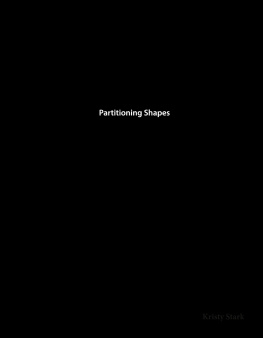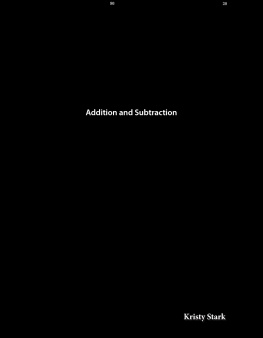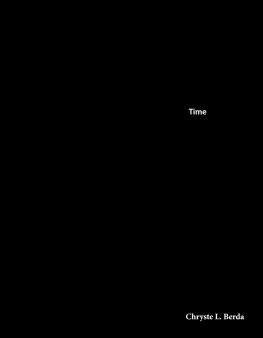Kristy Stark - Fun and Games: Fields, Rinks, and Courts: Partitioning Shapes
Here you can read online Kristy Stark - Fun and Games: Fields, Rinks, and Courts: Partitioning Shapes full text of the book (entire story) in english for free. Download pdf and epub, get meaning, cover and reviews about this ebook. year: 2018, publisher: Teacher Created Materials, genre: Children. Description of the work, (preface) as well as reviews are available. Best literature library LitArk.com created for fans of good reading and offers a wide selection of genres:
Romance novel
Science fiction
Adventure
Detective
Science
History
Home and family
Prose
Art
Politics
Computer
Non-fiction
Religion
Business
Children
Humor
Choose a favorite category and find really read worthwhile books. Enjoy immersion in the world of imagination, feel the emotions of the characters or learn something new for yourself, make an fascinating discovery.
- Book:Fun and Games: Fields, Rinks, and Courts: Partitioning Shapes
- Author:
- Publisher:Teacher Created Materials
- Genre:
- Year:2018
- Rating:5 / 5
- Favourites:Add to favourites
- Your mark:
- 100
- 1
- 2
- 3
- 4
- 5
Fun and Games: Fields, Rinks, and Courts: Partitioning Shapes: summary, description and annotation
We offer to read an annotation, description, summary or preface (depends on what the author of the book "Fun and Games: Fields, Rinks, and Courts: Partitioning Shapes" wrote himself). If you haven't found the necessary information about the book — write in the comments, we will try to find it.
Fun and Games: Fields, Rinks, and Courts: Partitioning Shapes — read online for free the complete book (whole text) full work
Below is the text of the book, divided by pages. System saving the place of the last page read, allows you to conveniently read the book "Fun and Games: Fields, Rinks, and Courts: Partitioning Shapes" online for free, without having to search again every time where you left off. Put a bookmark, and you can go to the page where you finished reading at any time.
Font size:
Interval:
Bookmark:
0covercover.xhtmlcover1page0001page0001.xhtml22page0002page0002.xhtmlFUN AND GAMES Fields Rinks and Courts Partitioning Shapes33page0003page0003.xhtml44page0004page0004.xhtmlTable of Contents Sporty Surfaces 4 Just for Kicks : Soccer 8 An Icy Sport : Curling 14 Bounce and Shoot : Basketball 20 Fun and Games 26 Problem Solving 28 Glossary 30 Index 31 Answer Key 3255page0005page0005.xhtmlSporty Surfaces The crowd goes wild! The players take the field. They skate onto the rink. They step onto the court. Sports are exciting. But before the action starts, take a time-out. Look down. That playing surface is special. It is designed for the sport that is played on it.66page0006page0006.xhtmlThe football teams have not run out on the field yet. Fans cheer at a soccer stadium.77page0007page0007.xhtmlSports such as soccer, football, rugby, and field hockey are played on fields. Fields can be made of real grass. But they do not have to be. Nylon or plastic turf looks like real grass. But no one needs to water or mow it. Rinks are enclosed areas with smooth surfaces. The floors can be made of ice or wood. Curling and hockey are sports that are played on ice rinks. Wooden rinks are often used for roller-skating or roller hockey. Courts can be indoors or outdoors. They are shaped like rectangles. Basketball, tennis, and volleyball are sports that are played on courts. An ice skater glides on a rink.88page0008page0008.xhtmlbasketball court tennis court99page0009page0009.xhtmlJust for Kicks: Soccer Soccer is the most played and watched sport in the world. Most fans call this sport football. It is known as soccer in North America. In soccer, players run up and down fields. They kick balls into nets to score goals. Most players can only use their hands to throw the ball back onto the field. Goalies can use their hands (and the rest of their bodies) to stop the other team from scoring goals. A goalie stops a goal.1010page0010page0010.xhtmlTwo soccer players try to kick the ball.1111page0011page0011.xhtmlGoals are placed at either end of a soccer field. The lines that border a field make a large rectangle. The size of a field depends on the ages of the players. For young players, the length of the field is about 30 yards (27 meters). The width is about 25 yd. (23m). Fields for adults are longer and wider. Fields can be up to 130 yd. (119 m) long. Fields can be up to 100 yd. (91 m) wide. A goalie gets ready to kick a ball on a field designed for adults.1212page0012page0012.xhtmlTeenagers play soccer on a smaller field.1313page0013page0013.xhtmlA halfway line divides a soccer field in half. The center circle is in the middle of the field. This circle is where the kickoff takes place. While one team kicks off, the other team's players must stay out of the center circle. They may enter it once the ball is kicked. During a game, players use other lines on the field to guide their play. Sidelines and goal lines mark the ends of fields. Lines show goal and penalty boxes. These are the only places where goalies can use their hands. goal box sideline penalty box center circle halfway line goal line1414page0014page0014.xhtmlLET'S EXPLORE MATH In soccer, it is important that fields are divided into equal parts. That helps to keep the game fair. 1. A halfway line partitions a soccer field in halves. Explain why each picture does or does not show halves. 2. Imagine that four soccer teams are running drills on the same practice field. Draw a practice field like the one below. Then, show how it can be partitioned so that each team gets an equal part of the field. a. b. c.1515page0015page0015.xhtmlAn Icy Sport: Curling Curling is a sport from Scotland. People have been competing in it since the 1500s! The surface used for curling is an ice rink. The rink is shaped like a rectangle. It is called a curling sheet. The sheet is 146 to 150 feet (45 to 46 m) long. It is about 15 ft. (5 m) wide. At the end of the curling sheet is a target. The target is called the house. It looks like a set of circles on the ice. curling sheet1616page0016page0016.xhtmlLET'S EXPLORE MATH Meg is watching curling. She notices that the house is partitioned in four equal parts. 1. How can you tell the parts are equal? 2. Which of the following phrases best describes the whole? A. four fours B. four fourths C. four1717page0017page0017.xhtmlTeams of four players compete in curling. They try to curl, or spin, stones across the ice. Ice used for curling is not smooth like ice used for skating. Curling ice has little bumps on it. The bumps stop stones from spinning too much. Each team has eight stones. Each stone weighs 42 pounds (19 kilograms). Teams score points for each stone that is closer to the center circle than the other team's stones. So, teams try to push their stones as close to the center of the house as they can. The yellow stone in the middle of the house will earn the most points.1818page0018page0018.xhtmlA curler prepares to push his stone.1919page0019page0019.xhtmlIt is a team effort to get a stone to the house. A player called the skip stands behind the house. This player looks at the ice and the stones. He or she tells the other players how and where to push the stones. The other two players use curling brooms to sweep the ice in front of the stone. This heats the ice and makes it slicker. Now, the stone can move straighter. Two curlers sweep the ice in front of a stone.2020page0020page0020.xhtmlA curler releases his stone.2121page0021page0021.xhtmlBounce and Shoot: Basketball Basketball was invented in 1891. The game started in the United States. Players shot the ball into peach baskets. The game had to stop to get the ball out. This made the game slow. Now, it is much faster. Basketball teams have five players. Players dribble a ball down a court. Then, they try to shoot it through a basket, or hoop. Points are scored for each basket. Of course, the other team tries to stop this from happening.2222page0022page0022.xhtmlLET'S EXPLORE MATH Imagine that a basketball coach asks four players to practice their dribbling. Each player needs an equal part of the gym. The coach draws a diagram to show players where to practice. Does each player get an equal part of the gym? Why or why not?2323page0023page0023.xhtmlBasketball games start in the center of a court. There is a large circle there. A midcourt line divides the circle in halves. Two players stand on his or her side of the midcourt line. A referee throws the ball into the air. Two players jump for it. When one of them tips it to a teammate, the fast-paced game begins! Players spread out and run up and down the whole court. sideline basket baseline midcourt line center circle free throw line three-point line2424page0024page0024.xhtmlLET'S EXPLORE MATH The circles in the center of basketball courts are often painted with team colors. Imagine that a team wants the circle on its court painted with three colors : yellow, red, and blue. The team wants to use an equal amount of each color. Which of the plans should the team select? A. B. C.2525page0025page0025.xhtmlBasketball courts are rectangles. Their hard surfaces are made of maple wood. Maple wood will not get damaged from a ball or players. Court sizes vary. Young players use courts that are 74 ft. (23 m) long and 42 ft. (13 m) wide. College and professional teams play on courts that are 94 ft. (29 m) long and 50 ft. (15 m) wide. Sidelines are the long sides of the court. Short sides are called baselines. If a ball goes past either of those lines, the game stops until a player throws it back in. basketball hoop2626page0026page0026.xhtmlA basketball player gets ready to pass the ball to a teammate.2727page0027page0027.xhtmlFun and Games The sizes and shapes of fields, rinks, and courts are regulated. They must be certain sizes and shapes. But, that does not mean they have to be boring! Some teams play on blue or red turf. Some ice skaters skate on orange ice for Halloween. A college basketball team in Florida has a court painted with palm trees. Sports surfaces have purposes. But, they can still be fun! This ice rink in Sweden has pink ice during the winter.2828page0028page0028.xhtmlA football player runs on blue turf.2929page0029page0029.xhtmlProblem Solving Raj and Kay are creating a game for their friends. The game will be for four players. Each player needs an equal part of the playing surface. Help Raj and Kay design the surface for their school. 1. The playground on the side of the school is a rectangle similar to the one shown. Draw two rectangles. Show two different ways that Raj and Kay can partition them into fourths. 2. The playground behind the school has a large circle painted on it, like the one shown. Raj and Kay want to be able to play the game there, too. Draw a circle. Show one way that Raj and Kay can partition it into fourths. 3. Raj and Kay want to increase the number of players to eight. Redesign your plans to show eight equal parts. Show or explain your thinking. Side of School Behind School3030page0030page0030.xhtml3131page0031page0031.xhtmlGlossary competing trying to win something that someone else is also trying to win damaged harmed or worsened designed made for a special purpose dribble move a ball forward by bouncing, tapping, or kicking it fast-paced happening or moving very quickly kickoff a kick that starts play in some sports partitions separates things into equal shares professional referring to a person who is paid for what he or she does referee a person who makes sure players follow the rules regulated controlled by rules vary change3232page0032page0032.xhtmlIndex basketball, courts, curling, fields, fourths, half, rink, Scotland, soccer, United States,3333page0033page0033.xhtmlAnswer Key Let's Explore Math page 13 : 1. a. Answers will vary but may include that halves are two equal parts, and this field shows three parts. b. Answers will vary but may include that halves are two equal parts, and these parts are not equal. c. Answers will vary but may include that this field has two equal parts so it shows halves. 2. Drawings will vary but should show a field partitioned into four equal parts. page 15 : 1. Answers will vary but may include that all four parts are the same size. 2. B page 21 : Yes, each player gets an equal part of the gym because the gym is divided into four equal parts, or fourths. page 23 : B Problem Solving 1. Drawings will vary but may include 2. Drawings will vary but may include 3. Answers will vary but may include dividing each fourth in half to show eight equal parts instead of four.3434page0034page0034.xhtmlMath Talk 1. What is the relationship between a whole and its parts? 2. If a shape has three unequal parts, is it an example of thirds? Why or why not? 3. Ms. Clark asks her students to partition rectangles into halves. How many equal parts will the rectangles have? Will all of the students make the same drawings? Why or why not? 4. How can you use folding or cutting to prove that all of the parts in a partitioned shape are equal? 5. Do equal parts of a whole always have to be the same shape? Explain your reasoning. 6. Why do you think it is important for people designing sports surfaces to use equal parts? Would the competition still be fair if they did not? Why or why not?3535page0035page0035.xhtmlFUN AND GAMES Fields Rinks and Courts Partitioning Shapes Before the kickoff, jump ball, or coin toss of a game, the playing surface must be designed. After all, each sport has a surface with a purpose! Explore how partitioned shapes are important to the fields, rinks, and courts of popular sports. Geometry36
Next pageFont size:
Interval:
Bookmark:
Similar books «Fun and Games: Fields, Rinks, and Courts: Partitioning Shapes»
Look at similar books to Fun and Games: Fields, Rinks, and Courts: Partitioning Shapes. We have selected literature similar in name and meaning in the hope of providing readers with more options to find new, interesting, not yet read works.
Discussion, reviews of the book Fun and Games: Fields, Rinks, and Courts: Partitioning Shapes and just readers' own opinions. Leave your comments, write what you think about the work, its meaning or the main characters. Specify what exactly you liked and what you didn't like, and why you think so.


















